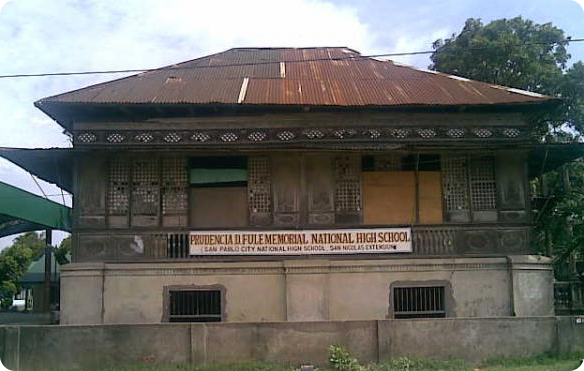San Pablo City’s faceless benefactor
The dilapidated century-old house in Barangay San Nicolas in San Pablo City never fails to catch the attention of motorists traveling along the Maharlika Highway. Its façade bears the signage “Prudencia D. Fule Memorial National High School” (PDFMNHS).
Creaky yet captivating, the Spanish-era stone abode or “bahay na bato” is the local government’s only public memorial to a woman who, in the 1930s, allowed her house and the rest of her 3,000-square-meter property to be used as an educational facility for young residents of San Pablo, then a bustling town.
Known in local history for her kindness and generosity, Fule or “Nanay Udeng”, however, has remained faceless. Not even a single photo of her has been found so that a monument can be built in her honor, according to Francis Dionglay, one of the schoolteachers.
Even her surviving relatives do not have any photo of her or any memorabilia whatsoever, Dionglay says. In one instance, he recalls, a relative arrived from abroad to visit and look for Fule’s photos but ended up only frustrated.
“The search will continue,” says Antonia Villanueva, the school principal, who wants to give Fule a fitting tribute, even a simple stone bust, to remind present and future generations of her philanthropy.
Article continues after this advertisementEducation site
Article continues after this advertisementIn the early 1930s, the unmarried Fule died from an illness without leaving any will or testament on how to dispose of her estate. The local government decided to use her house and lot for a public school. It was an annex to the elementary school from across the street.
In early 2000, the house was converted into three classrooms and was used as an extension of the city high school. Villanueva says classes have not been conducted there since two years ago for safety reasons and after the school population rose to over 700.
The teachers attribute the battered condition of Fule’s house to a family who had occupied it for five years on a claim that they were relatives of Fule.
Dionglay says the family’s “forced occupancy” of the house was questioned before the court, which subsequently ruled that they did not have documents to prove that they were indeed Fule’s relatives. The court declared that the city government has legal rights to the property.
It was not known when the house was built but, Dionglay said, it could be slightly older than the one owned by the Abrigo clan in the nearby village of San Benito. “The Abrigo house would reach its centennial next year,” he says, quoting a clan member as saying.
Another schoolteacher, Donny Aris Malvar, made a research and found that the two-story Fule house was constructed in the twilight years of the Spanish regime. It was a status symbol during the Spanish period and used to be a landmark gateway to San Pablo de los Montes, the city’s name when it was then a municipality.
Original design
The original house plan had an anteroom, living room, bedroom, dining area with kitchen, an azotea at the back and two comfort rooms.
“The stairs are made of stone covered with tiles supported by crafted concrete balusters and columns of Corinthian tastes. The roof columns have wood carvings of flowers encircling every step of the staircase,” Malvar says.
The roof’s outline is decorated with a floral design made from galvanized sheet, while the wooden wall panels in the dining room and kitchen are painted with fruits and staple food.
Malvar says the arched-foundation of the azotea had served as stables and saddle area for horses pulling a carriage and boats transporting harvests.
He claims Fule’s house was once a refuge of the local revolutionary hero, Gen. Miguel Malvar, when he was hunted by American forces during the US pacification campaign at the turn of the 19th century.
“The hero hid under the rice depository (bakul) which can be found below the house,” he says.
When Fule got sick, she transferred to the mansion of Don Potenciano Malvar, the first mayor of San Pablo and her brother-in-law, at the poblacion (town proper). She died there.
As Fule did not leave any last will and testament, her unnamed next of kin agreed to donate her house and landholdings to the municipality, to be used for educational purposes.
Ruins
Its once imposing columns battered by the forces of nature and its elegant interiors vandalized, Fule’s house has become “ruins of an old residence forgotten by time,” Malvar says.
The teachers say they had already approached several national government agencies to help preserve the house because of its historical value and for it to be converted into a museum. They got no reply.
Several years back, the local government allotted funds for its preservation, but the money was apparently not used because it was occupied then by Fule’s alleged relatives, they say.
